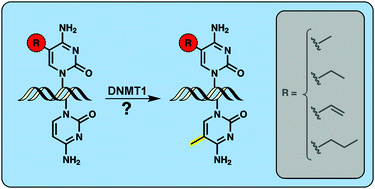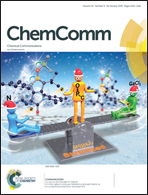Can 5-methylcytosine analogues with extended alkyl side chains guide DNA methylation?†
Abstract
5-Methylcytosine (MeC) is an endogenous modification of DNA that plays a crucial role in DNA–protein interactions, chromatin structure, epigenetic regulation, and DNA repair. MeC is produced via enzymatic methylation of the C-5 position of cytosine by DNA-methyltransferases (DNMT) which use S-adenosylmethionine (SAM) as a cofactor. Hemimethylated CG dinucleotides generated as a result of DNA replication are specifically recognized and methylated by maintenance DNA methyltransferase 1 (DNMT1). The accuracy of DNMT1-mediated methylation is essential for preserving tissue-specific DNA methylation and thus gene expression patterns. In the present study, we synthesized DNA duplexes containing MeC analogues with modified C-5 side chains and examined their ability to guide cytosine methylation by the human DNMT1 protein. We found that the ability of 5-alkylcytosines to direct cytosine methylation decreased with increased alkyl chain length and rigidity (methyl > ethyl > propyl ∼ vinyl). Molecular modeling studies indicated that this loss of activity may be caused by the distorted geometry of the DNA–protein complex in the presence of unnatural alkylcytosines.

- This article is part of the themed collection: Nucleic Acid Modifications


 Please wait while we load your content...
Please wait while we load your content...